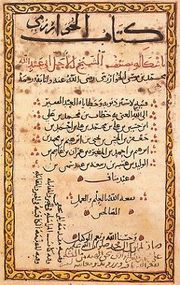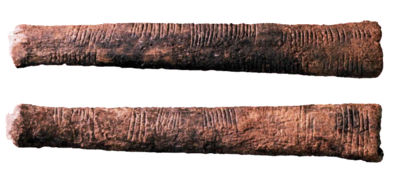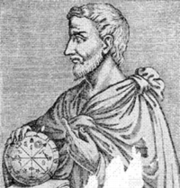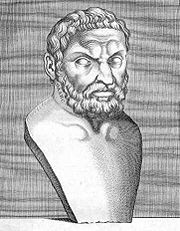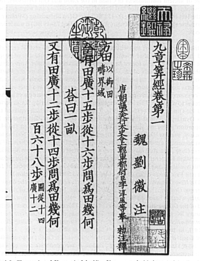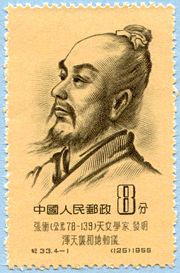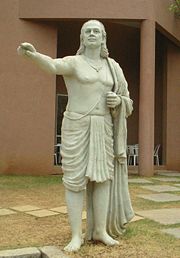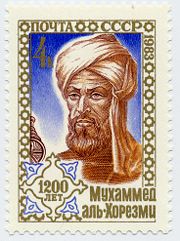History of mathematics
2008/9 Schools Wikipedia Selection. Related subjects: Mathematics
The area of study known as the history of mathematics is primarily an investigation into the origin of new discoveries in mathematics, to a lesser extent an investigation into the standard mathematical methods and notation of the past.
Before the modern age and the worldwide spread of knowledge, written examples of new mathematical developments have come to light only in a few locales. The most ancient mathematical texts available are Plimpton 322 ( Babylonian mathematics ca. 1900 BC), the Moscow Mathematical Papyrus ( Egyptian mathematics ca. 1850 BC), the Rhind Mathematical Papyrus (Egyptian mathematics ca. 1650 BC), and the Shulba Sutras (Indian mathematics ca. 800 BC). All of these texts concern the so-called Pythagorean theorem, which seems to be the most ancient and widespread mathematical development after basic arithmetic and geometry.
Egyptian and Babylonian mathematics were then further developed in Greek and Hellenistic mathematics, which is generally considered to be one of the most important for greatly expanding both the method and the subject matter of mathematics. The mathematics developed in these ancient civilizations were then further developed and greatly expanded in Islamic mathematics. Many Greek and Arabic texts on mathematics were then translated into Latin in medieval Europe and further developed there.
One striking feature of the history of ancient and medieval mathematics is that bursts of mathematical development were often followed by centuries of stagnation. Beginning in Renaissance Italy in the 16th century, new mathematical developments, interacting with new scientific discoveries, were made at an ever increasing pace, and this continues to the present day.
Early mathematics
Long before the earliest written records, there are drawings that do indicate a knowledge of mathematics and of measurement of time based on the stars. For example, paleontologists have discovered ochre rocks in a cave in South Africa adorned with scratched geometric patterns dating back to c. 70,000 BC. Also prehistoric artifacts discovered in Africa and France, dated between 35,000 BC and 20,000 BC, indicate early attempts to quantify time.
Evidence exists that early counting involved women who kept records of their monthly biological cycles; twenty-eight, twenty-nine, or thirty scratches on bone or stone, followed by a distinctive scratching on the bone or stone, for example. Moreover, hunters had the concepts of one, two, and many, as well as the idea of none or zero, when considering herds of animals.
The Ishango Bone, found in the area of the headwaters of the Nile River (northeastern Congo), dates as early as 20,000 BC. One common interpretation is that the bone is the earliest known demonstration of sequences of prime numbers and Ancient Egyptian multiplication. Predynastic Egyptians of the 5th millennium BC pictorially represented geometric spatial designs. It has been claimed that Megalithic monuments in England and Scotland from the 3rd millennium BC, incorporate geometric ideas such as circles, ellipses, and Pythagorean triples in their design.
The earliest known mathematics in ancient India dates back to circa 3000- 2600 BC in the Indus Valley Civilization (Harappan civilization) of North India and Pakistan, which developed a system of uniform weights and measures that used the decimal system, a surprisingly advanced brick technology which utilised ratios, streets laid out in perfect right angles, and a number of geometrical shapes and designs, including cuboids, barrels, cones, cylinders, and drawings of concentric and intersecting circles and triangles. Mathematical instruments discovered include an accurate decimal ruler with small and precise subdivisions, a shell instrument that served as a compass to measure angles on plane surfaces or in horizon in multiples of 40–360 degrees, a shell instrument used to measure 8–12 whole sections of the horizon and sky, and an instrument for measuring the positions of stars for navigational purposes. The Indus script has not yet been deciphered; hence very little is known about the written forms of Harappan mathematics. Archeological evidence has led some historians to believe that this civilization used a base 8 numeral system and possessed knowledge of the ratio of the length of the circumference of the circle to its diameter, thus a value of π. Dating from the Shang Dynasty ( 1600— 1046 BC), the earliest extant Chinese mathematics consists of numbers scratched on tortoise shell . These numbers use a decimal system, so that the number 123 is written (from top to bottom) as the symbol for 1 followed by the symbol for a hundred, then the symbol for 2 followed by the symbol for ten, then the symbol for 3. This was the most advanced number system in the world at the time and allowed calculations to be carried out on the suan pan or Chinese abacus. The date of the invention of the suan pan is not certain, but the earliest written reference was in AD 190 in the Supplementary Notes on the Art of Figures written by Xu Yue.
Ancient Near East (c. 1800-500 BC)
Mesopotamia
Babylonian mathematics refers to any mathematics of the peoples of Mesopotamia (modern Iraq) from the days of the early Sumerians until the beginning of the Hellenistic period. It is named Babylonian mathematics due to the central role of Babylon as a place of study, which ceased to exist during the Hellenistic period. From this point, Babylonian mathematics merged with Greek and Egyptian mathematics to give rise to Hellenistic mathematics. Later under the Arab Empire, Iraq/Mesopotamia, especially Baghdad, once again became an important centre of study for Islamic mathematics.
In contrast to the sparsity of sources in Egyptian mathematics, our knowledge of Babylonian mathematics is derived from more than 400 clay tablets unearthed since the 1850s. Written in Cuneiform script, tablets were inscribed whilst the clay was moist, and baked hard in an oven or by the heat of the sun. Some of these appear to be graded homework.
The earliest evidence of written mathematics dates back to the ancient Sumerians, who built the earliest civilization in Mesopotamia. They developed a complex system of metrology from 3000 BC. From around 2500 BC onwards, the Sumerians wrote multiplication tables on clay tablets and dealt with geometrical exercises and division problems. The earliest traces of the Babylonian numerals also date back to this period.
The majority of recovered clay tablets date from 1800 to 1600 BC, and cover topics which include fractions, algebra, quadratic and cubic equations, and the calculation of Pythagorean triples (see Plimpton 322). The tablets also include multiplication tables, trigonometry tables and methods for solving linear and quadratic equations. The Babylonian tablet YBC 7289 gives an approximation to √2 accurate to five decimal places.
Babylonian mathematics was written using a sexagesimal (base-60) numeral system. From this we derive the modern day usage of 60 seconds in a minute, 60 minutes in an hour, and 360 (60 x 6) degrees in a circle. Babylonian advances in mathematics were facilitated by the fact that 60 has many divisors. Also, unlike the Egyptians, Greeks, and Romans, the Babylonians had a true place-value system, where digits written in the left column represented larger values, much as in the decimal system. They lacked, however, an equivalent of the decimal point, and so the place value of a symbol often had to be inferred from the contex.
Egypt
Egyptian mathematics refers to mathematics written in the Egyptian language. From the Hellenistic period, Greek replaced Egyptian as the written language of Egyptian scholars, and from this point Egyptian mathematics merged with Greek and Babylonian mathematics to give rise to Hellenistic mathematics. Mathematical study in Egypt later continued under the Arab Empire as part of Islamic mathematics, when Arabic became the written language of Egyptian scholars.
The oldest mathematical text discovered so far is the Moscow papyrus, which is an Egyptian Middle Kingdom papyrus dated c. 2000—1800 BC. Like many ancient mathematical texts, it consists of what are today called "word problems" or "story problems", which were apparently intended as entertainment. One problem is considered to be of particular importance because it gives a method for finding the volume of a frustum: "If you are told: A truncated pyramid of 6 for the vertical height by 4 on the base by 2 on the top. You are to square this 4, result 16. You are to double 4, result 8. You are to square 2, result 4. You are to add the 16, the 8, and the 4, result 28. You are to take one third of 6, result 2. You are to take 28 twice, result 56. See, it is 56. You will find it right."
The Rhind papyrus (c. 1650 BC ) is another major Egyptian mathematical text, an instruction manual in arithmetic and geometry. In addition to giving area formulas and methods for multiplication, division and working with unit fractions, it also contains evidence of other mathematical knowledge (see ), including composite and prime numbers; arithmetic, geometric and harmonic means; and simplistic understandings of both the Sieve of Eratosthenes and perfect number theory (namely, that of the number 6) . It also shows how to solve first order linear equations as well as arithmetic and geometric series .
Also, three geometric elements contained in the Rhind papyrus suggest the simplest of underpinnings to analytical geometry: (1) first and foremost, how to obtain an approximation of π accurate to within less than one percent; (2) second, an ancient attempt at squaring the circle; and (3) third, the earliest known use of a kind of cotangent.
Finally, the Berlin papyrus (c. 1300 BC ) shows that ancient Egyptians could solve a second-order algebraic equation .
Ancient Indian mathematics (c. 900 BC — AD 200)
Vedic mathematics begins in the early Iron Age, with the Shatapatha Brahmana (c. 9th century BC), which approximates the value of π to 2 decimal places. , and the Sulba Sutras (c. 800-500 BC) were geometry texts that used irrational numbers, prime numbers, the rule of three and cube roots; computed the square root of 2 to five decimal places; gave the method for squaring the circle; solved linear equations and quadratic equations; developed Pythagorean triples algebraically and gave a statement and numerical proof of the Pythagorean theorem.
Pāṇini (c. 5th century BC) formulated the grammar rules for Sanskrit. His notation was similar to modern mathematical notation, and used metarules, transformations, and recursions with such sophistication that his grammar had the computing power equivalent to a Turing machine. Pingala (roughly 3rd-1st centuries BC) in his treatise of prosody uses a device corresponding to a binary numeral system. His discussion of the combinatorics of meters, corresponds to the binomial theorem. Pingala's work also contains the basic ideas of Fibonacci numbers (called mātrāmeru). The Brāhmī script was developed at least from the Maurya dynasty in the 4th century BC, with recent archeological evidence appearing to push back that date to around 600 BC. The Brahmi numerals date to the 3rd century BC.
Between 400 BC and AD 200, Jaina mathematicians began studying mathematics for the sole purpose of mathematics. They were the first to develop transfinite numbers, set theory, logarithms, fundamental laws of indices, cubic equations, quartic equations, sequences and progressions, permutations and combinations, squaring and extracting square roots, and finite and infinite powers. The Bakhshali Manuscript written between 200 BC and AD 200 included solutions of linear equations with up to five unknowns, the solution of the quadratic equation, arithmetic and geometric progressions, compound series, quadratic indeterminate equations, simultaneous equations, and the use of zero and negative numbers. Accurate computations for irrational numbers could be found, which includes computing square roots of numbers as large as a million to at least 11 decimal places.
Greek and Hellenistic mathematics (c. 550 BC—AD 300)
Greek mathematics refers to mathematics written in Greek between about 600 BCE and 450 CE. Greek mathematicians lived in cities spread over the entire Eastern Mediterranean, from Italy to North Africa, but were united by culture and language. Greek mathematics is sometimes called Hellenistic mathematics.
Greek mathematics was much more sophisticated than the mathematics that had been developed by earlier cultures. All surviving records of pre-Greek mathematics show the use of inductive reasoning, that is, repeated observations used to establish rules of thumb. Greek mathematicians, by contrast, used deductive reasoning. The Greeks used logic to derive conclusions from definitions and axioms.
Greek mathematics is thought to have begun with Thales (c. 624—c.546 BC) and Pythagoras (c. 582—c. 507 BC). Although the extent of the influence is disputed, they were probably inspired by the ideas of Egypt, Mesopotamia and perhaps India. According to legend, Pythagoras travelled to Egypt to learn mathematics, geometry, and astronomy from Egyptian priests.
Thales used geometry to solve problems such as calculating the height of pyramids and the distance of ships from the shore. Pythagoras is credited with the first proof of the Pythagorean theorem, though the statement of the theorem has a long history. In his commentary on Euclid, Proclus states that Pythagoras expressed the theorem that bears his name and constructed Pythagorean triples algebraically rather than geometrically. The Academy of Plato had the motto "let none unversed in geometry enter here".
The Pythagoreans discovered the existence of irrational numbers. Eudoxus (408 —c.355 BC) invented the method of exhaustion, a precursor of modern integration. Aristotle (384—c.322 BC) first wrote down the laws of logic. Euclid (c. 300 BC) is the earliest example of the format still used in mathematics today, definition, axiom, theorem, proof. He also studied conics. His book, Elements, was known to all educated people in the West until the middle of the 20th century. In addition to the familiar theorems of geometry, such as the Pythagorean theorem, Elements includes a proof that the square root of two is irrational and that there are infinitely many prime numbers. The Sieve of Eratosthenes (ca. 230 BC) was used to discover prime numbers.
Some say the greatest of Greek mathematicians, if not of all time, was Archimedes ( 287— 212 BC) of Syracuse. According to Plutarch, at the age of 75, while drawing mathematical formulas in the dust, he was run through with a spear by a Roman soldier. Ancient Rome left little evidence of any interest in pure mathematics.
Classical Chinese mathematics (c. 500 BC—AD 1300)
In China, in 212 BC, the Emperor Qin Shi Huang (Shi Huang-ti) commanded that all books outside of Qin state to be burned. While this order was not universally obeyed, as a consequence little is known with certainty about ancient Chinese mathematics.
From the Western Zhou Dynasty (from 1046 BC), the oldest mathematical work to survive the book burning is the I Ching, which uses the 8 binary 3- tuples (trigrams) and 64 binary 6- tuples (hexagrams) for philosophical, mathematical, and/or mystical purposes. The binary tuples are composed of broken and solid lines, called yin 'female' and yang 'male' respectively (see King Wen sequence).
The oldest existent work on geometry in China comes from the philosophical Mohist canon of c. 330 BC, compiled by the followers of Mozi (470 BC-390 BC). The Mo Jing described various aspects of many fields associated with physical science, and provided a small wealth of information on mathematics as well.
After the book burning, the Han dynasty (202 BC–220 AD) produced works of mathematics which presumably expand on works that are now lost. The most important of these is The Nine Chapters on the Mathematical Art, the full title of which appeared by 179 AD, but existed in part under other titles beforehand. It consists of 246 word problems, involving agriculture, business, employment of geometry to figure height spans and dimension ratios for Chinese pagoda towers, engineering, surveying, and includes material on right triangles and π. It also made use of Cavalieri's principle on volume more than a thousand years before Cavalieri would propose it in the West. It created mathematical proof for Pythagoras' Pythagorean theorem, and mathematical formula for Gaussian elimination. The work was commented on by Liu Hui in the 3rd century AD.
In addition, the mathematical works of the Han astronomer and inventor Zhang Heng (78-139 AD) had a formulation for pi as well, which differed from Liu Hui's calculation. Zhang Heng used his formula of pi to find spherical volume. There was also the written work of the mathematician and music theorist Jing Fang (78–37 BC); by using the Pythagorean comma, Jing observed that 53 just fifths approximates to 31 octaves. This would later lead to the discovery of 53 equal temperament, and was not calculated precisely elsewhere until the German Nicholas Mercator did so in the 17th century.
The Chinese also made use of the complex combinatorial diagram known as the 'magic square and magic circles which was described in ancient times and perfected by Yang Hui (1238–1398 AD).
Zu Chongzhi (5th century) of the Southern and Northern Dynasties computed the value of π to seven decimal places, which remained the most accurate value of π for almost 1000 years.
In the thousand years following the Han dynasty, starting in the Tang dynasty and ending in the Song dynasty, Chinese mathematics thrived at a time when European mathematics did not exist. Developments first made in China, and only much later known in the West, include negative numbers, the binomial theorem, matrix methods for solving systems of linear equations and the Chinese remainder theorem. The Chinese also developed Pascal's triangle and the rule of three long before it was known in Europe. Besides Zu Chongzhi, some of the most important figures of Chinese mathematics during this period include Yi Xing, Shen Kuo, Qin Jiushao, Zhu Shijie, and others. The scientist Shen Kuo used problems involving calculus, trigonometry, metrology, permutations, and once computed the possible amount of terrain space that could be used with specific battle formations, as well as the longest possible military campaign given the amount of food carriers could bring for themselves and soldiers.
Even after European mathematics began to flourish during the Renaissance, European and Chinese mathematics were separate traditions, with significant Chinese mathematical output in decline, until the Jesuit missionaries such as Matteo Ricci carried mathematical ideas back and forth between the two cultures from the 16th to 18th centuries.
Classical Indian mathematics (c. 400—1600)
The Surya Siddhanta (c. 400) introduced the trigonometric functions of sine, cosine, and inverse sine, and laid down rules to determine the true motions of the luminaries, which conforms to their actual positions in the sky. The cosmological time cycles explained in the text, which was copied from an earlier work, corresponds to an average sidereal year of 365.2563627 days, which is only 1.4 seconds longer than the modern value of 365.25636305 days. This work was translated to Arabic and Latin during the Middle Ages.
Aryabhata in 499 introduced the versine function, produced the first trigonometric tables of sine, developed techniques and algorithms of algebra, infinitesimals, differential equations, and obtained whole number solutions to linear equations by a method equivalent to the modern method, along with accurate astronomical calculations based on a heliocentric system of gravitation. An Arabic translation of his Aryabhatiya was available from the 8th century, followed by a Latin translation in the 13th century. He also computed the value of π to the fourth decimal place as 3.1416. Madhava later in the 14th century computed the value of π to the eleventh decimal place as 3.14159265359.
In the 7th century, Brahmagupta identified the Brahmagupta theorem, Brahmagupta's identity and Brahmagupta's formula, and for the first time, in Brahma-sphuta-siddhanta, he lucidly explained the use of zero as both a placeholder and decimal digit and explained the Hindu-Arabic numeral system. It was from a translation of this Indian text on mathematics (around 770) that Islamic mathematicians were introduced to this numeral system, which they adapted as Arabic numerals. Islamic scholars carried knowledge of this number system to Europe by the 12th century, and it has now displaced all older number systems throughout the world. In the 10th century, Halayudha's commentary on Pingala's work contains a study of the Fibonacci sequence and Pascal's triangle, and describes the formation of a matrix.
In the 12th century, Bhaskara first conceived differential calculus, along with the concepts of the derivative, differential coefficient and differentiation. He also stated Rolle's theorem (a special case of the mean value theorem), studied Pell's equation, and investigated the derivative of the sine function. From the 14th century, Madhava and other Kerala School mathematicians, further developed his ideas. They developed the concepts of mathematical analysis and floating point numbers, and concepts fundamental to the overall development of calculus, including the mean value theorem, term by term integration, the relationship of an area under a curve and its antiderivative or integral, tests of convergence, iterative methods for solutions of non-linear equations, and a number of infinite series, power series, Taylor series and trigonometric series. In the 16th century, Jyeshtadeva consolidated many of the Kerala School's developments and theorems in the Yuktibhasa, the world's first differential calculus text, which also introduced concepts of integral calculus. Mathematical progress in India became stagnant from the late 16th century onwards due to subsequent political turmoil.
Islamic mathematics (c. 800—1500)
The Islamic Arab Empire established across the Middle East, Central Asia, North Africa, Iberia, and in parts of India in the 8th century made significant contributions towards mathematics. Although most Islamic texts on mathematics were written in Arabic, they were not all written by Arabs, since much like the status of Greek in the Hellenistic world, Arabic was used as the written language of non-Arab scholars throughout the Islamic world at the time. Some of the most important Islamic mathematicians were Persian.
Muḥammad ibn Mūsā al-Ḵwārizmī, a 9th century Persian mathematician and astronomer to the Caliph of Baghdad, wrote several important books on the Hindu-Arabic numerals and on methods for solving equations. His book On the Calculation with Hindu Numerals, written about 825, along with the work of the Arab mathematician Al-Kindi, were instrumental in spreading Indian mathematics and Indian numerals to the West. The word algorithm is derived from the Latinization of his name, Algoritmi, and the word algebra from the title of one of his works, Al-Kitāb al-mukhtaṣar fī hīsāb al-ğabr wa’l-muqābala (The Compendious Book on Calculation by Completion and Balancing). Al-Khwarizmi is often called the "father of algebra", for his preservation of ancient algebraic methods and for his original contributions to the field. Further developments in algebra were made by Abu Bakr al-Karaji (953—1029) in his treatise al-Fakhri, where he extends the methodology to incorporate integer powers and integer roots of unknown quantities. In the 10th century, Abul Wafa translated the works of Diophantus into Arabic and developed the tangent function.
The first known proof by mathematical induction appears in a book written by Al-Karaji around 1000 AD, who used it to prove the binomial theorem, Pascal's triangle, and the sum of integral cubes. The historian of mathematics, F. Woepcke, praised Al-Karaji for being "the first who introduced the theory of algebraic calculus." Ibn al-Haytham was the first mathematician to derive the formula for the sum of the fourth powers, and using the method of induction, he developed a method for determining the general formula for the sum of any integral powers, which was fundamental to the development of integral calculus.
Omar Khayyam, the 12th century poet, was also a mathematician, and wrote Discussions of the Difficulties in Euclid, a book about flaws in Euclid's Elements, especially the parallel postulate, and thus he laid the foundations for analytic geometry and non-Euclidean geometry. He was also the first to find the general geometric solution to cubic equations. He was also very influential in calendar reform. The Persian mathematician Nasir al-Din Tusi (Nasireddin) in the 13th century made advances in spherical trigonometry. He also wrote influential work on Euclid's parallel postulate. In the 15th century, Ghiyath al-Kashi computed the value of π to the 16th decimal place. Kashi also had an algorithm for calculating nth roots, which was a special case of the methods given many centuries later by Ruffini and Horner. Other notable Muslim mathematicians included al-Samawal, Abu'l-Hasan al-Uqlidisi, Jamshid al-Kashi, Thabit ibn Qurra, Abu Kamil and Abu Sahl al-Kuhi.
Other achievements of Muslim mathematicians during this period include the development of algebra and algorithms (see Muhammad ibn Mūsā al-Khwārizmī), the invention of spherical trigonometry, the addition of the decimal point notation to the Arabic numerals, the discovery of all the modern trigonometric functions besides sine, al-Kindi's introduction of cryptanalysis and frequency analysis, al-Karaji's introduction of algebraic calculus and proof by mathematical induction, the development of analytic geometry and the earliest general formula for infinitesimal and integral calculus by Ibn al-Haytham, the beginning of algebraic geometry by Omar Khayyam, the first refutations of Euclidean geometry and the parallel postulate by Nasīr al-Dīn al-Tūsī, the first attempt at a non-Euclidean geometry by Sadr al-Din, and numerous other advances in algebra, arithmetic, calculus, cryptography, geometry, number theory and trigonometry.
During the time of the Ottoman Empire (from the 15th century) the development of Islamic mathematics became stagnant. This parallels the stagnation of mathematics when the Romans conquered the Hellenistic world.
John J. O'Connor and Edmund F. Robertson wrote in the MacTutor History of Mathematics archive:
"Recent research paints a new picture of the debt that we owe to Islamic mathematics. Certainly many of the ideas which were previously thought to have been brilliant new conceptions due to European mathematicians of the sixteenth, seventeenth and eighteenth centuries are now known to have been developed by Arabic/Islamic mathematicians four centuries earlier. In many respects, the mathematics studied today is far closer in style to that of Islamic mathematics than to that of Hellenistic mathematics."
Medieval European mathematics (c. 500—1400)
Medieval European interest in mathematics was driven by concerns quite different from those of modern mathematicians. One driving element was the belief that mathematics provided the key to understanding the created order of nature, frequently justified by Plato's Timaeus and the biblical passage that God had "ordered all things in measure, and number, and weight" (Wisdom 11:21).
Early Middle Ages (c. 500—1100)
Boethius provided a place for mathematics in the curriculum when he coined the term " quadrivium" to describe the study of arithmetic, geometry, astronomy, and music. He wrote De institutione arithmetica, a free translation from the Greek of Nicomachus's Introduction to Arithmetic; De institutione musica, also derived from Greek sources; and a series of excerpts from Euclid's Geometry. His works were theoretical, rather than practical, and were the basis of mathematical study until the recovery of Greek and Arabic mathematical works.
Rebirth of mathematics in Europe (1100—1400)
In the 12th century, European scholars travelled to Spain and Sicily seeking scientific Arabic texts, including al-Khwarizmi's al-Jabr wa-al-Muqabilah, translated into Latin by Robert of Chester, and the complete text of Euclid's Elements, translated in various versions by Adelard of Bath, Herman of Carinthia, and Gerard of Cremona.
These new sources sparked a renewal of mathematics. Fibonacci, writing in the Liber Abaci, in 1202 and updated in 1254, produced the first significant mathematics in Europe since the time of Eratosthenes, a gap of more than a thousand years. The work introduced Hindu-Arabic numerals to Europe, and discussed many other mathematical problems. The fourteenth century saw the development of new mathematical concepts to investigate a wide range of problems. One important area that contributed to the development of mathematics concerned the analysis of local motion.
Thomas Bradwardine proposed that speed (V) increases in arithmetic proportion as the ratio of force (F) to resistance (R) increases in geometric proportion. Bradwardine expressed this by a series of specific examples, but although the logarithm had not yet been invented, we can express his conclusion anachronistically by writing: V = log (F/R). Bradwardine's analysis is an example of transferring a mathematical technique used by al-Kindi and Arnald of Villanova to quantify the nature of compound medicines to a different physical problem.
One of the 14th-century Oxford Calculators, William Heytesbury, lacking differential calculus and the concept of limits, proposed to measure instantaneous speed "by the path that would be described by [a body] if ... it were moved uniformly at the same degree of speed with which it is moved in that given instant".
Heytesbury and others mathematically determined the distance covered by a body undergoing uniformly accelerated motion (which we would solve by a simple integration), stating that "a moving body uniformly acquiring or losing that increment [of speed] will traverse in some given time a [distance] completely equal to that which it would traverse if it were moving continuously through the same time with the mean degree [of speed]".
Nicole Oresme at the University of Paris and the Italian Giovanni di Casali independently provided graphical demonstrations of this relationship, asserting that the area under the line depicting the constant acceleration, represented the total distance traveled. In a later mathematical commentary on Euclid's Geometry, Oresme made a more detailed general analysis in which he demonstrated that a body will acquire in each successive increment of time an increment of any quality that increases as the odd numbers. Since Euclid had demonstrated the sum of the odd numbers are the square numbers, the total quality acquired by the body increases as the square of the time.
Early modern European mathematics (c. 1400—1600)
In Europe at the dawn of the Renaissance, mathematics was still limited by the cumbersome notation using Roman numerals and expressing relationships using words, rather than symbols: there was no plus sign, no equal sign, and no use of x as an unknown.
In 16th century European mathematicians began to make advances without precedent anywhere in the world, so far as is known today. The first of these was the general solution of cubic equations, generally credited to Scipione del Ferro circa 1510, but first published by Johannes Petreius in Nuremberg in Gerolamo Cardano's Ars magna, which also included the solution of the general quartic equation from Cardano's student Lodovico Ferrari .
From this point on, mathematical developments came swiftly, contributing to and benefiting from contemporary advances in the physical sciences. This progress was greatly aided by advances in printing. The earliest mathematical books printed were Peurbach's Theoricae nova planetarum 1472 followed by a book on commercial arithmetic, the 1478 Treviso Arithmetic and then the first real mathematics book Euclid's Elements printed and published by Ratdolt 1482
Driven by the demands of navigation and the growing need for accurate maps of large areas, trigonometry grew to be a major branch of mathematics. Bartholomaeus Pitiscus was the first to use the word, publishing his Trigonometria in 1595. Regiomontanus' table of sines and cosines was published in 1533.
By century's end, thanks to Regiomontanus (1436—1476) and François Vieta (1540—1603), among others, mathematics was written using Hindu-Arabic numerals and in a form not too different from the notation used today.
17th century
The 17th century saw an unprecedented explosion of mathematical and scientific ideas across Europe. Galileo, an Italian, observed the moons of Jupiter in orbit about that planet, using a telescope based on a toy imported from Holland. Tycho Brahe, a Dane, had gathered an enormous quantity of mathematical data describing the positions of the planets in the sky. His student, Johannes Kepler, a German, began to work with this data. In part because he wanted to help Kepler in his calculations, John Napier, in Scotland, was the first to investigate natural logarithms. Kepler succeeded in formulating mathematical laws of planetary motion. The analytic geometry developed by René Descartes (1596-1650), a French mathematician and philosopher, allowed those orbits to be plotted on a graph, in Cartesian coordinates. Building on earlier work by many mathematicians, Isaac Newton, an Englishman, discovered the laws of physics explaining Kepler's Laws, and brought together the concepts now known as calculus. Independently, Gottfried Wilhelm Leibniz, in Germany, developed calculus and much of the calculus notation still in use today. Science and mathematics had become an international endeavor, which would soon spread over the entire world.
In addition to the application of mathematics to the studies of the heavens, applied mathematics began to expand into new areas, with the correspondence of Pierre de Fermat and Blaise Pascal. Pascal and Fermat set the groundwork for the investigations of probability theory and the corresponding rules of combinatorics in their discussions over a game of gambling. Pascal, with his wager, attempted to use the newly developing probability theory to argue for a life devoted to religion, on the grounds that even if the probability of success was small, the rewards were infinite. In some sense, this foreshadowed the development of utility theory in the 18th-19th century.
18th century
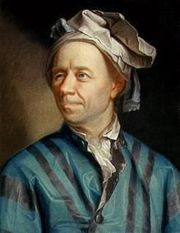
As we have seen, knowledge of the natural numbers, 1, 2, 3,..., as preserved in monolithic structures, is older than any surviving written text. The earliest civilizations -- in Mesopotamia, Egypt, India and China -- knew arithmetic.
One way to view the development of the various number systems of modern mathematics is to see new numbers studied and investigated to answer questions about arithmetic performed on older numbers. In prehistoric times, fractions answered the question: what number, when multiplied by 3, gives the answer 1? In India and China, and much later in Germany, negative numbers were developed to answer the question: what do you get when you subtract a larger number from a smaller? The invention of the zero may have followed from similar question: what do you get when you subtract a number from itself?
Another natural question is: what kind of a number is the square root of two? The Greeks knew that it was not a fraction, and this question may have played a role in the development of continued fractions. But a better answer came with the invention of decimals, developed by John Napier (1550 - 1617) and perfected later by Simon Stevin. Using decimals, and an idea that anticipated the concept of the limit, Napier also studied a new constant, which Leonhard Euler (1707 - 1783) named e.
Euler was very influential in the standardization of other mathematical terms and notations. He named the square root of minus 1 with the symbol i. He also popularized the use of the Greek letter π to stand for the ratio of a circle's circumference to its diameter. He then derived one of the most remarkable identities in all of mathematics:
(see Euler's Identity.)
19th century
Throughout the 19th century mathematics became increasingly abstract. In this century lived one of the greatest mathematicians of all time, Carl Friedrich Gauss (1777 - 1855). Leaving aside his many contributions to science, in pure mathematics he did revolutionary work on functions of complex variables, in geometry, and on the convergence of series. He gave the first satisfactory proofs of the fundamental theorem of algebra and of the quadratic reciprocity law.
This century saw the development of the two forms of non-Euclidean geometry, where the parallel postulate of Euclidean geometry no longer holds. The Russian mathematician Nikolai Ivanovich Lobachevsky and his rival, the Hungarian mathematician Janos Bolyai, independently discovered hyperbolic geometry, where uniqueness of parallels no longer holds. In this geometry the sum of angles in a triangle add up to less than 180°. Elliptic geometry was developed later in the 19th century by the German mathematician Bernhard Riemann; here no parallel can be found and the angles in a triangle add up to more than 180°. Riemann also developed Riemannian geometry, which unifies and vastly generalizes the three types of geometry, and he defined the concept of a manifold, which generalize the ideas of curves and surfaces. Also in the nineteenth century William Rowan Hamilton developed noncommutative algebra.
In addition to new directions in mathematics, older mathematics were given a stronger logical foundation, especially in the case of calculus, in work by Augustin-Louis Cauchy and Karl Weierstrass.
A new form of algebra was developed in the nineteenth century called Boolean algebra, invented by the British mathematician George Boole. It was a system in which the only numbers were 0 and 1, a system which today has important applications in computer science.
Also, for the first time, the limits of mathematics were explored. Niels Henrik Abel, a Norwegian, and Évariste Galois, a Frenchman, proved that there is no general algebraic method for solving polynomial equations of degree greater than four. Other 19th century mathematicians utilized this in their proofs that straightedge and compass alone are not sufficient to trisect an arbitrary angle, to construct the side of a cube twice the volume of a given cube, nor to construct a square equal in area to a given circle. Mathematicians had vainly attempted to solve all of these problems since the time of the ancient Greeks.
Abel and Galois's investigations into the solutions of various polynomial equations laid the groundwork for further developments of group theory, and the associated fields of abstract algebra. In the 20th century physicists and other scientists have seen group theory as the ideal way to study symmetry.
Towards the end of the 19th century, Georg Cantor invented the set theory, which has become the common language of different mathematical branches. The introduction of infinite set set off a debate on foundations of mathematics.
The 19th century also saw the founding of the first mathematical societies: the London Mathematical Society in 1865, the Société Mathématique de France in 1872, the Circolo Mathematico di Palermo in 1884, the Edinburgh Mathematical Society in 1883, and the American Mathematical Society in 1888.
Before the 20th century, there were very few creative mathematicians in the world at any one time. For the most part, mathematicians were either born to wealth, like Napier, or supported by wealthy patrons, like Gauss. There were a few who found meager livelihoods teaching at a university, like Fourier. Niels Henrik Abel, unable to obtain a position, died in poverty of malnutrition and tuberculosis at the age of twenty-six.
20th century
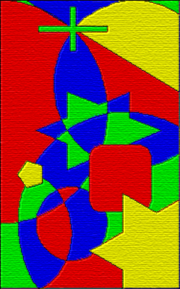
The profession of mathematician became much more important in the 20th century. Every year, hundreds of new Ph.D.s in mathematics are awarded, and jobs are available both in teaching and industry. Mathematical development has grown at an exponential rate, with too many new developments for a survey to even touch on any but a few of the most profound.
In 1900, David Hilbert presented a list of 23 unsolved problems in mathematics at the International Congress of Mathematicians. These problems spanned many areas of mathematics and have formed a central focus for much of 20th century mathematics. Today ten have been resolved, seven are partially resolved and two problems are still open. The remaining four are too loose to be stated as resolved or not.
In the 1910s, Srinivasa Aiyangar Ramanujan (1887-1920) developed over 3000 theorems, including properties of highly composite numbers, the partition function and its asymptotics, and mock theta functions. He also made major breakthroughs and discoveries in the areas of gamma functions, modular forms, divergent series, hypergeometric series and prime number theory.
In 1931, Kurt Gödel published his two incompleteness theorems which state the limit of mathematical logic. It put an end to David Hilbert's dream of a complete and consistent mathematical system.
Famous conjectures of the past yielded to new and more powerful techniques. Wolfgang Haken and Kenneth Appel used a computer to prove the four colour theorem in 1976. Andrew Wiles, working alone in his office for years, proved Fermat's last theorem in 1995. Mathematical collaborations of unprecedented size and scope took place. The classification of finite simple groups (also called the "enormous theorem") spanned tens of thousands of pages in 500-odd journal articles written by about 100 authors, published mostly between 1955 and 1983.
Entire new areas of mathematics such as mathematical logic, topology, complexity theory, and game theory changed the kinds of questions that could be answered by mathematical methods.
The French Bourbaki Group attempted to bring all of mathematics into a coherent rigorous whole, publishing under the pseudonym Nicolas Bourbaki. Their extensive work had a controversial influence on mathematical education.
There were also new investigations of limitations to mathematics. Kurt Gödel proved that in any mathematical system that includes the integers, there are true statements that cannot be proved. Paul Cohen proved the independence of the continuum hypothesis from the standard axioms of set theory.
By the end of the century, mathematics was even finding its way into art, as fractal geometry produced beautiful shapes never before seen.
21st century
At the dawn of the 21st century, many educators express concerns about a new underclass, the mathematically and scientifically illiterate. At the same time, mathematics, science, engineering, and technology have together created knowledge, communication, and prosperity undreamed of by ancient philosophers.
In mid-March, 2007, a team of researchers throughout North America and Europe used networks of computers to map E8. Although it is not yet known exactly how this understanding of E8 can be applied, the discovery was a great mark of both teamwork and computational technology in modern mathematics.
